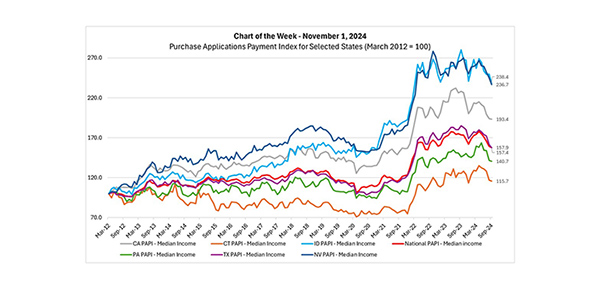
Chart of the Week: Purchase Applications Payment Index for Selected States

Sources: MBA Weekly Applications Survey and U.S. Bureau of Labor Statistics.
As attendees from this year’s MBA Annual Convention and Expo returned to their respective states, many messages are top of mind. One priority is supply and affordability.
While estimates of housing underproduction in the U.S. vary, a new report from Up for Growth puts the gap between the housing we have and the housing we need at 3.85 million units. Importantly, the report emphasizes that the problem is nationwide, although at differing degrees, as the “shortage shows signs of stabilizing in some regions while others worsen.” This week’s Federal Housing Finance Agency’s House Price Index release (for August data) shows that twelve-month house price changes have moderated versus the situation one year ago, but remain at 4.2% nationally and positive in every region of the country. Together, these signal that the monthly cost burden of purchasing a new home, as interest rates stay high and house prices continue to rise, remains a central issue across all regions.
Last week’s release of MBA’s Purchase Applications Payment Index (PAPI) for September, which uses Weekly Applications Survey (WAS) data to measure how new fixed-rate 30-year purchase mortgage payments vary across time relative to income, shows that while affordability levels remain low relative to levels before 2022, homebuyer affordability conditions have improved for five consecutive months since the PAPI series high in April (red line). Indeed, as interest rates fell (temporarily) below 6.2% in September, overall affordability reached its highest level since August 2022.
This week’s MBA Chart of the Week shows the national PAPI series and the series for six selected states. Contrasting two states, Pennsylvania and Nevada (green and dark blue lines), we see similar patterns – large increases in PAPI in 2022 and low affordability since. In Pennsylvania, the index hit 145 in the middle of 2022 (i.e., the real median loan payment was 45% higher than in March 2012), increased to a high of 164 in May 2024, and moderated to 141 in September. In Nevada – the second highest PAPI state after Idaho – PAPI maxed out at 278 in October 2022 and has since receded to 237 in September 2024. That is, despite recent improvement, the real median loan payment in Nevada is 137% higher than it was in March 2012.
Overall new home affordability is now at its highest level since August 2022, but the recent jump in rates will likely cause conditions to plateau. While MBA is forecasting for rates to be around 6.3% by the end of the year and below 6.0% by the middle of next year, it is imperative for the gap between the housing we have and the housing we need to be decreased meaningfully before the PAPI retreats to meaningfully lower levels and affordability notably improves across the country.
